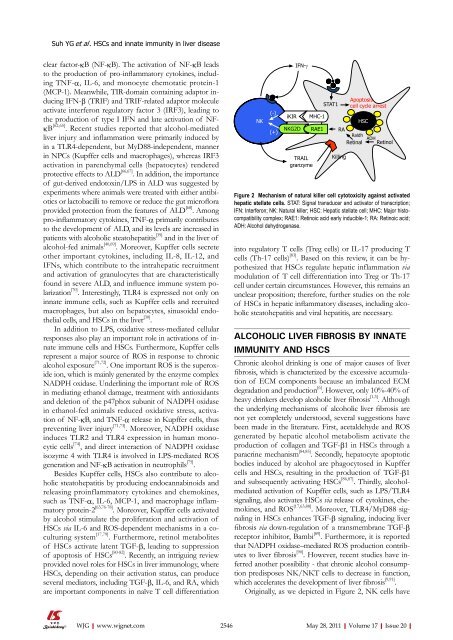20 - World Journal of Gastroenterology
20 - World Journal of Gastroenterology
20 - World Journal of Gastroenterology
Create successful ePaper yourself
Turn your PDF publications into a flip-book with our unique Google optimized e-Paper software.
Suh YG et al . HSCs and innate immunity in liver disease<br />
clear factor-κB (NF-κB). The activation <strong>of</strong> NF-κB leads<br />
to the production <strong>of</strong> pro-inflammatory cytokines, including<br />
TNF-α, IL-6, and monocyte chemotatic protein-1<br />
(MCP-1). Meanwhile, TIR-domain containing adaptor inducing<br />
IFN-β (TRIF) and TRIF-related adaptor molecule<br />
activate interferon regulatory factor 3 (IRF3), leading to<br />
the production <strong>of</strong> type I IFN and late activation <strong>of</strong> NFκB<br />
[62,65] . Recent studies reported that alcohol-mediated<br />
liver injury and inflammation were primarily induced by<br />
in a TLR4-dependent, but MyD88-independent, manner<br />
in NPCs (Kupffer cells and macrophages), whereas IRF3<br />
activation in parenchymal cells (hepatocytes) rendered<br />
protective effects to ALD [66,67] . In addition, the importance<br />
<strong>of</strong> gut-derived endotoxin/LPS in ALD was suggested by<br />
experiments where animals were treated with either antibiotics<br />
or lactobacilli to remove or reduce the gut micr<strong>of</strong>lora<br />
provided protection from the features <strong>of</strong> ALD [68] . Among<br />
pro-inflammatory cytokines, TNF-α primarily contributes<br />
to the development <strong>of</strong> ALD, and its levels are increased in<br />
patients with alcoholic steatohepatitis [39] and in the liver <strong>of</strong><br />
alcohol-fed animals [40,69] . Moreover, Kupffer cells secrete<br />
other important cytokines, including IL-8, IL-12, and<br />
IFNs, which contribute to the intrahepatic recruitment<br />
and activation <strong>of</strong> granulocytes that are characteristically<br />
found in severe ALD, and influence immune system polarization<br />
[70] . Interestingly, TLR4 is expressed not only on<br />
innate immune cells, such as Kupffer cells and recruited<br />
macrophages, but also on hepatocytes, sinusoidal endothelial<br />
cells, and HSCs in the liver [30] .<br />
In addition to LPS, oxidative stress-mediated cellular<br />
responses also play an important role in activations <strong>of</strong> innate<br />
immune cells and HSCs. Furthermore, Kupffer cells<br />
represent a major source <strong>of</strong> ROS in response to chronic<br />
alcohol exposure [71,72] . One important ROS is the superoxide<br />
ion, which is mainly generated by the enzyme complex<br />
NADPH oxidase. Underlining the important role <strong>of</strong> ROS<br />
in mediating ethanol damage, treatment with antioxidants<br />
and deletion <strong>of</strong> the p47phox subunit <strong>of</strong> NADPH oxidase<br />
in ethanol-fed animals reduced oxidative stress, activation<br />
<strong>of</strong> NF-κB, and TNF-α release in Kupffer cells, thus<br />
preventing liver injury [71,73] . Moreover, NADPH oxidase<br />
induces TLR2 and TLR4 expression in human monocytic<br />
cells [74] , and direct interaction <strong>of</strong> NADPH oxidase<br />
isozyme 4 with TLR4 is involved in LPS-mediated ROS<br />
generation and NF-κB activation in neutrophils [75] .<br />
Besides Kupffer cells, HSCs also contribute to alcoholic<br />
steatohepatitis by producing endocannabinoids and<br />
releasing proinflammatory cytokines and chemokines,<br />
such as TNF-α, IL-6, MCP-1, and macrophage inflammatory<br />
protein-2 [63,76-78] . Moreover, Kupffer cells activated<br />
by alcohol stimulate the proliferation and activation <strong>of</strong><br />
HSCs via IL-6 and ROS-dependent mechanisms in a coculturing<br />
system [17,79] . Furthermore, retinol metabolites<br />
<strong>of</strong> HSCs activate latent TGF-β, leading to suppression<br />
<strong>of</strong> apoptosis <strong>of</strong> HSCs [80-82] . Recently, an intriguing review<br />
provided novel roles for HSCs in liver immunology, where<br />
HSCs, depending on their activation status, can produce<br />
several mediators, including TGF-β, IL-6, and RA, which<br />
are important components in naïve T cell differentiation<br />
WJG|www.wjgnet.com<br />
NK<br />
(-)<br />
(+)<br />
iKIR<br />
IFN-γ<br />
MHC-1<br />
NKG2D RAE1<br />
TRAIL<br />
granzyme<br />
into regulatory T cells (Treg cells) or IL-17 producing T<br />
cells (Th-17 cells) [83] . Based on this review, it can be hypothesized<br />
that HSCs regulate hepatic inflammation via<br />
modulation <strong>of</strong> T cell differentiation into Treg or Th-17<br />
cell under certain circumstances. However, this remains an<br />
unclear proposition; therefore, further studies on the role<br />
<strong>of</strong> HSCs in hepatic inflammatory diseases, including alcoholic<br />
steatohepatitis and viral hepatitis, are necessary.<br />
ALCOHOLIC LIVER FIBROSIS BY INNATE<br />
IMMUNITY AND HSCS<br />
STAT1<br />
Apoptosis<br />
cell cycle arrest<br />
HSC<br />
Chronic alcohol drinking is one <strong>of</strong> major causes <strong>of</strong> liver<br />
fibrosis, which is characterized by the excessive accumulation<br />
<strong>of</strong> ECM components because an imbalanced ECM<br />
degradation and production [6] . However, only 10%-40% <strong>of</strong><br />
heavy drinkers develop alcoholic liver fibrosis [1,3] . Although<br />
the underlying mechanisms <strong>of</strong> alcoholic liver fibrosis are<br />
not yet completely understood, several suggestions have<br />
been made in the literature. First, acetaldehyde and ROS<br />
generated by hepatic alcohol metabolism activate the<br />
production <strong>of</strong> collagen and TGF-β1 in HSCs through a<br />
paracrine mechanism [84,85] . Secondly, hepatocyte apoptotic<br />
bodies induced by alcohol are phagocytosed in Kupffer<br />
cells and HSCs, resulting in the production <strong>of</strong> TGF-β1<br />
and subsequently activating HSCs [86,87] . Thirdly, alcoholmediated<br />
activation <strong>of</strong> Kupffer cells, such as LPS/TLR4<br />
signaling, also activates HSCs via release <strong>of</strong> cytokines, chemokines,<br />
and ROS [17,63,88] . Moreover, TLR4/MyD88 signaling<br />
in HSCs enhances TGF-β signaling, inducing liver<br />
fibrosis via down-regulation <strong>of</strong> a transmembrane TGF-β<br />
receptor inhibitor, Bambi [89] . Furthermore, it is reported<br />
that NADPH oxidase–mediated ROS production contributes<br />
to liver fibrosis [90] . However, recent studies have inferred<br />
another possibility - that chronic alcohol consumption<br />
predisposes NK/NKT cells to decrease in function,<br />
which accelerates the development <strong>of</strong> liver fibrosis [9,91] .<br />
Originally, as we depicted in Figure 2, NK cells have<br />
2546 May 28, <strong>20</strong>11|Volume 17|Issue <strong>20</strong>|<br />
RA<br />
Killing<br />
Raldh<br />
ADH<br />
Retinal Retinol<br />
Figure 2 Mechanism <strong>of</strong> natural killer cell cytotoxicity against activated<br />
hepatic stellate cells. STAT: Signal transducer and activator <strong>of</strong> transcription;<br />
IFN: Interferon; NK: Natural killer; HSC: Hepatic stellate cell; MHC: Major histocompatibility<br />
complex; RAE1: Retinoic acid early inducible-1; RA: Retinoic acid;<br />
ADH: Alcohol dehydrogenase.

















